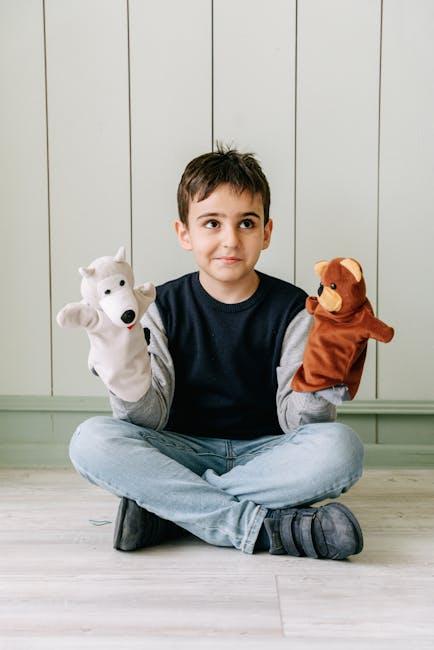In today’s households, where pets are often cherished members of the family, a common question arises: should dogs be allowed to play with children’s toys? This seemingly simple query opens a gateway to understanding the dynamics of shared spaces and the nurturing of both pets and children. As we explore this topic, we’ll consider the benefits and potential drawbacks of allowing our canine companions to romp with toys traditionally reserved for children. With a warm and instructive approach, we’ll delve into the ways in which this practice can foster harmony and joy in a home, while also highlighting the practical considerations to ensure safety and happiness for all. Whether you’re a pet owner, a parent, or both, this discussion aims to provide insights and guidance to help you make informed decisions that enhance the well-being of your entire family.
Understanding the Playtime Needs of Dogs and Children
Dogs and children both have an innate need for play, which is crucial for their physical and mental development. When considering whether dogs should be allowed to play with children’s toys, it’s essential to weigh the benefits against potential risks. Understanding the distinct playtime requirements of both can help create a harmonious environment. Dogs often engage in play that involves chewing and tugging, which might lead to damage or potential hazards if the toy isn’t designed to withstand such activities. Conversely, children benefit from toys that promote cognitive and motor skills development, often requiring a different set of durability and safety standards.
To ensure safety and enjoyment for both parties, consider the following strategies:
- Designate specific toys for your dog that are durable and safe for chewing.
- Supervise playtime when your dog and child interact with toys to prevent accidental swallowing or breakage.
- Educate children on the differences between their toys and their pet’s toys, emphasizing respect for shared spaces.
- Choose versatile toys that can be used by both, ensuring they’re robust and non-toxic.
By understanding and respecting the distinct needs of dogs and children, you can foster a safe and fun environment that nurtures the bond between them.

Ensuring Safety and Hygiene in Shared Play Spaces
Creating a safe and hygienic environment in shared play spaces requires careful consideration, especially when both children and dogs are involved. Safety and cleanliness are paramount, and maintaining these standards ensures that everyone enjoys the play area without compromising their health. Here are some key practices to implement:
- Regular Cleaning: Clean toys and play equipment regularly using pet-safe and child-friendly disinfectants. This helps in preventing the spread of germs and allergens.
- Toy Segregation: Consider having separate toys for dogs and children. This not only prevents wear and tear but also reduces the risk of dogs accidentally ingesting small parts.
- Supervised Play: Always supervise playtime. This ensures that both dogs and children interact safely, preventing any accidental injuries or mishaps.
By adhering to these guidelines, shared play spaces can remain a joyful and secure environment for both children and their furry friends. Encouraging respect and understanding between kids and dogs further fosters a harmonious play setting.
Choosing the Right Toys for Both Kids and Canines
When selecting playthings for both children and dogs, it’s essential to consider safety, durability, and enjoyment. Safety is paramount; ensure toys are made from non-toxic materials and are free from small parts that could pose a choking hazard. Look for sturdy construction that can withstand the enthusiastic chewing of a playful pup and the rough handling of an energetic child.
- Durability: Choose toys designed to endure the unique wear and tear from both kids and canines.
- Size Appropriateness: Ensure toys are the right size to prevent swallowing or choking.
- Interactive Features: Opt for toys that encourage interactive play, fostering a bond between your child and pet.
Incorporating shared toys into playtime can enhance the bond between your child and their furry friend, promoting social skills and empathy. Consider multi-functional toys like rope pulls or rubber balls that can engage both parties in a game of fetch or tug-of-war. Always supervise playtime to ensure a safe and enjoyable experience for everyone involved.

Fostering Positive Interactions Between Dogs and Children
In the harmonious world of pets and children, it’s essential to ensure that interactions remain positive and enriching for both parties. Allowing dogs to engage with children’s toys can be a delightful experience, but it requires thoughtful consideration. Here are some tips to create a joyful and safe environment:
– Select Appropriate Toys: Choose toys that are safe for both dogs and children. Look for durable, non-toxic materials that can withstand the playful antics of both.
– Supervision is Key: Always supervise playtime to prevent any accidental swallowing of small parts or overly rough play. This ensures that both your child and pet feel secure and cared for.
– Teach Boundaries: Educate your child about respecting the dog’s space and belongings. Similarly, train your dog to understand which toys are theirs and which belong to the child.
– Foster Sharing and Bonding: Encourage games that involve both the child and the dog, such as fetch or tug-of-war with a robust toy. This can strengthen their bond and teach mutual respect.
Creating a shared play environment not only nurtures a child’s empathy and understanding of animals but also provides a dog with companionship and engagement, fostering a loving and joyful household.

